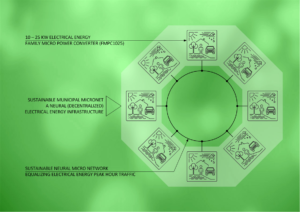As per our mission statement, we do care very much!
First – Special attention is given to the “Cradle to Cradle” concept, utilizing reprocessed raw materials, precious metals, parts and components to give them a second run of life. Re-employ the labor force with reprocessed materials and components of the existing energy networks to build a new sustainable electrical energy infrastructure affordably for future generations.
Second – To eliminate long distance, inefficient, and heat dissipating energy transportation / transformation, electrical energy conversion is to be carried out at the point of usage on demand. Copying mother nature will guaranty sustainability – “harmonizing by decentralizing” – The Neural Approach.
Third – The biggest benefit to enhance electrical energy storage capacity is the harmonized modular EE-Storage container technology, allowing the electrical energy stored within E-Vehicles to be utilized by E-Buildings and vice versa. This will eliminate the need for public charge stations in the long run.

Fourth – Minimizing consumption of electrical energy through an “ECO3” invention, the Digital Neural Cell (DNC), allowing to eliminate all central wiring at “The Last Mile”, resulting in the reduction of wiring (material & labor) of up to 90%, reduction of converter and storage capacity of 50% plus, since all electric energy applications & appliances operate via looped Control & Power P2P Neural Networks respectively.
Transition To Sustainability / Summary
- Deconstruction of existing energy transportation network
- Utilization & retraining of existing & new labor force
- Deconstruction of decommissioned fossil fueled vehicles
- Utilization & retraining of existing & new labor force
- Collection & reprocessing of deconstructed materials
- Utilization & retraining of existing & new labor force
- Design & construction of E-Buildings & E-Vehicles
- Utilization & retraining of existing & new labor force
- Design & construction of new neural electric energy network
- Utilization & retraining of existing & new labor force
- Design & construction of additional energy conversion technologies
- Utilization & retraining of existing & new labor force
- Design & construction of services & maintenance network
- Utilization & retraining of existing & new labor force
